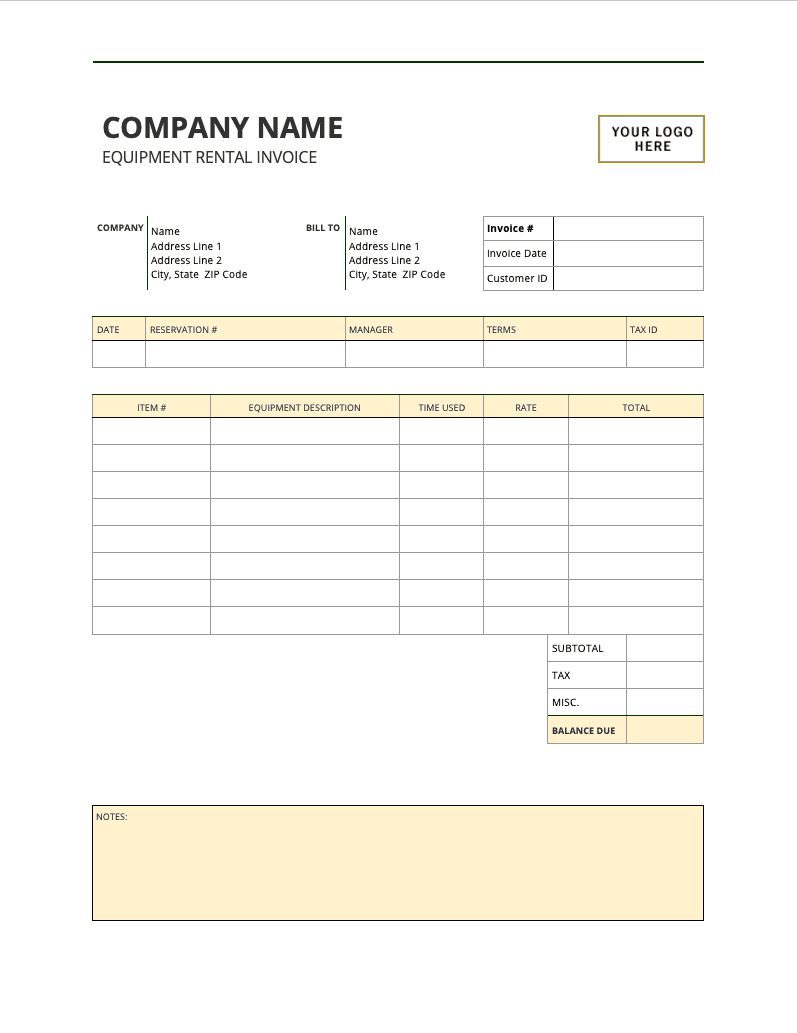Equipment Rental Invoice
An equipment rental invoice is a post-rental document that is printed or emailed to a business or individual client to explain what they are required to pay in exchange for the time they spent renting one (1) or more pieces of equipment. Included is a description of each item (with space for a model number), the date the equipment was taken, when it was brought back, the taxes owed, the total amount the client needs to pay, and space for any personal notes to the customer. Unlike a receipt, the invoice is given after the client has used and returned the equipment.
Common Types of Rental Equipment
The sky’s the limit for rental equipment. Literally, you can rent anything from high reach equipment like a telescopic boom lift or scissor lift, to a trenching excavator. The most commonly rented equipment includes:
- Excavators
- Forklifts
- Generators
- Floor polishers
- Tile strippers
- Scissor lifts
- Paint sprayers
- And much more.
How to Determine Equipment Rental Rates
Determining equipment rental rates is more difficult than it seems at first glance. If you own something and want to rent it out, you need to remember that the equipment will depreciate in value over time, and you also need to account for the price of insurance, the overhead for your rental storage company, as well as miscellaneous costs.
The original cost of the item will determine the rental fee; in general the more expensive the equipment, the more it will cost to rent. There are many online calculators to determine what to charge. Make sure to include the entire cost of the equipment, any interest you have paid to buy it, the cost of your overhead such as insurance and warehouse operating costs, as well as the profit margin you are looking for.
Equipment Rental Business Tips
If you want to begin an equipment rental business, there are several tips you need to remember to get you started.
- First, study the market in which you want to start the business. For instance, it does not make sense to rent a snowplow to customers in Florida. See what other companies are renting, and what will be sought after by the customers. Don’t buy equipment that no one will rent. That is a waste of money and the space you need to store it.
- As far as buying the equipment, you don’t need to buy top of the line equipment. Will customers really pay more to spend four hours with the top brand? Probably not. Make sure you will be able to recoup the money on your investment. You should also consider buying used equipment, as long as it is in good shape, which would lower your price point. One tip you do need to keep in mind, however, is to keep your equipment clean and well maintained. No one wants to rent a power tool that is sluggish or dirty. Clean, well-running rentals will ensure repeat business.
- Take the time to promote your business. Make sure you have a top of the line website that is user-friendly and will help customers get the answers and equipment they need without any hassles. Also, consider pairing up with other businesses in the area to help each other advertise. These symbiotic relationships, like a lawn maintenance service advertising for your lawn care rentals, can help both of your companies acquire and maintain new customers.
- Make sure you stay on top of the necessary paperwork and accounting. Dealing with the fine print is not necessarily fun, but an important part of running your small business. Make sure that you have clearly printed invoices for your customers that delineate all of the rental information. Another element of paperwork you need to consider is to have the appropriate insurance for all of your rentals. This will keep you and your business safe in the case of a mishap.
